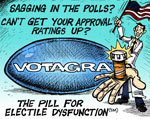Vitamin E Benefits for Women - Natural Treatment for PMS and Symptoms of Menopause
| Share on Facebook | Share on Twitter | Share on Google+ |
Vitamin E supplements are helpful for women throughout their lives, both before and after menopause. And the form of vitamin E that works is the most common and least expensive form of vitamin E, vitamin E acetate (also known as d-alpha-tocopherol acetate and dl-alpha-tocopheryl acetate).
Women of reproductive age may benefit from extra vitamin E around the time of menstruation. Many women experience unpleasant changes during the days of their menstrual cycle when estrogen levels begin to go back up, usually at the beginning and through the first 14 days of a woman's period. The added estrogen stimulates the growth of breast tissue and uterine tissue, along with any fibrocystic breast "lumps" and any fibroid growths in the uterus itself. These growths hurt.
The beginnings of the surge in estrogen at just before the period can also trigger a condition known as PMS, or premenstrual syndrome. This is the time of the month a woman's body accumulates fluid, and the additional fluid can cause weight gain, headache, and body aches and pains. (Estrogen does not, incidentally, cause the more serious condition PMDD, or premenstrual dysphoric disorder, which lasts longer, occurs at a different stage of the menstrual period, and causes much more severe symptoms.)
Researchers have found that taking 400 IU of vitamin E reduces the symptoms of PMS after about three months. It doesn't end premenstrual discomfort entirely, but it goes a long way toward making it more bearable. Women may also benefit from calcium, magnesium, and vitamin C, taken in divided doses several times a day, since there are limits to how much the body can absorb.
And for this application, the "cheap stuff," d-alpha-tocopherol acetate and dl-alpha-tocopheryl acetate work just fine. The body uses them to build up stores of vitamin E that are used just for a few days in every menstrual cycle.
Women going through menopause may benefit from vitamin E as a treatment for hot flashes. Several clinical studies originating in the Middle East have found that taking a combination of 400 IU of alpha-tocopherol along with 400 milligrams of vitamin tocotrienols every day is very useful for controlling hot flashes.
A study of healthy menopausal women conducted by doctors in Iran concluded that taking this dosage of vitamin E every day for 4 weeks reduced the average frequency of hot flashes from five a day to three. The vitamin E also made the hot flashes much less severe. American studies of women who have had breast cancer also show that vitamin E tends to reduce the frequency of hot flashes, although not as much.(Visit vitamin E and hot flashes for more information)
Women of all ages can also benefit from the cardiovascular and anti-cancer qualities of vitamin E, but for these benefits, the "cheap stuff" won't work. For cancer prevention and cardiovascular protection, it's best to take a mixture of vitamin E succinate and tocotrienols, at least 200 IU of succinate plus 200 mg of tocotrienols every day. And women who get regular physical exercise may find that taking any form of vitamin E before a workout, especially a workout involving weight lifting or resistance training, may prevent aches and pains and make building new muscle easier.
Selected References:
Ziaei S, Kazemnejad A, Zareai M. The effect of vitamin E on hot flashes in menopausal women. Gynecol Obstet Invest. 2007;64(4):204 - 7. Epub 2007 Jul 30.
-
Skin CareMen Skin Care
-
Free ResourcesFree eBooks
-
Health is not a condition of matter, but of Mind.Mary Baker Eddy
-
What We RecommendIf you do an analysis of the ingredients in a bottle of
 Total Balance and compare with other products you will find that it provides exceptional value for money…even against simple mass produced products with lower bottle costs.
Total Balance and compare with other products you will find that it provides exceptional value for money…even against simple mass produced products with lower bottle costs.
-



















